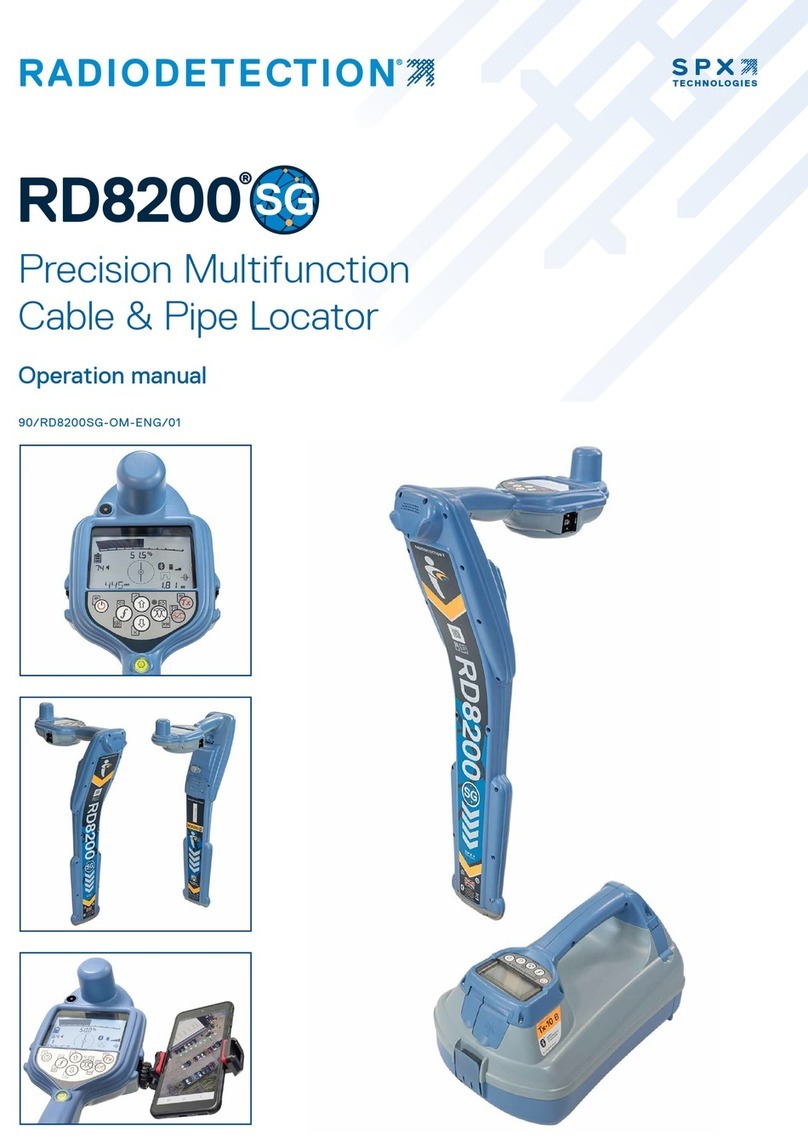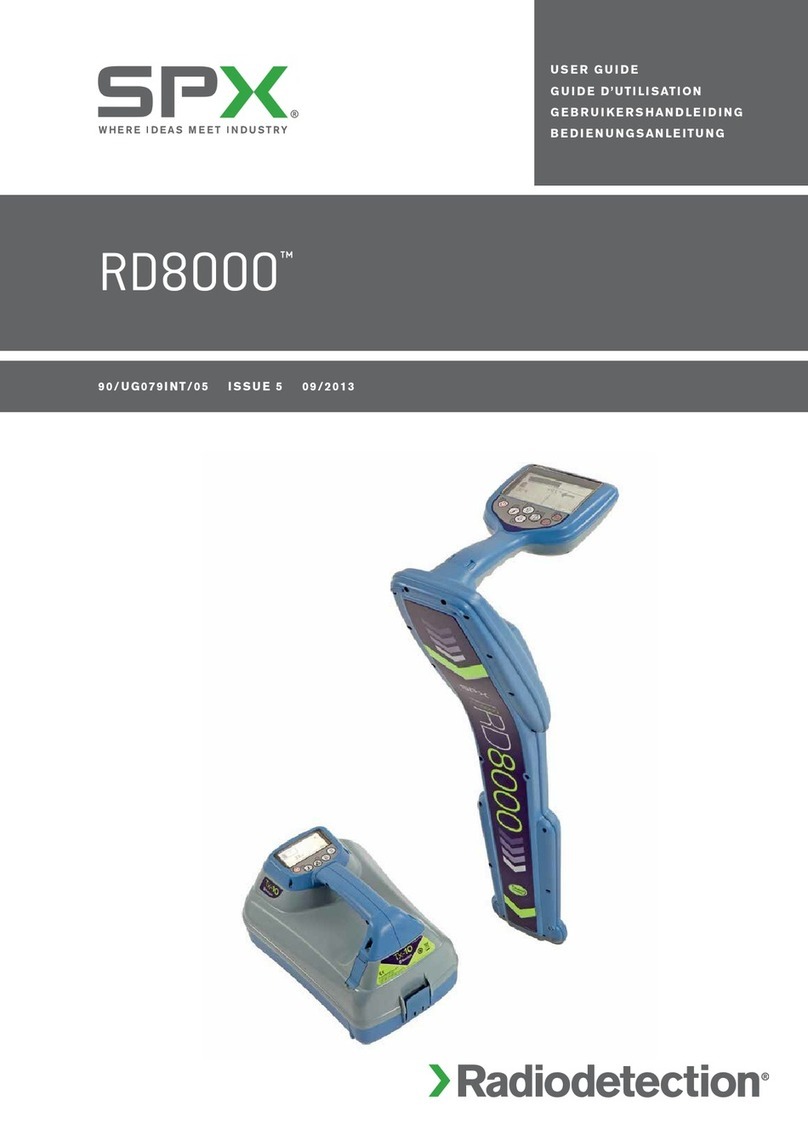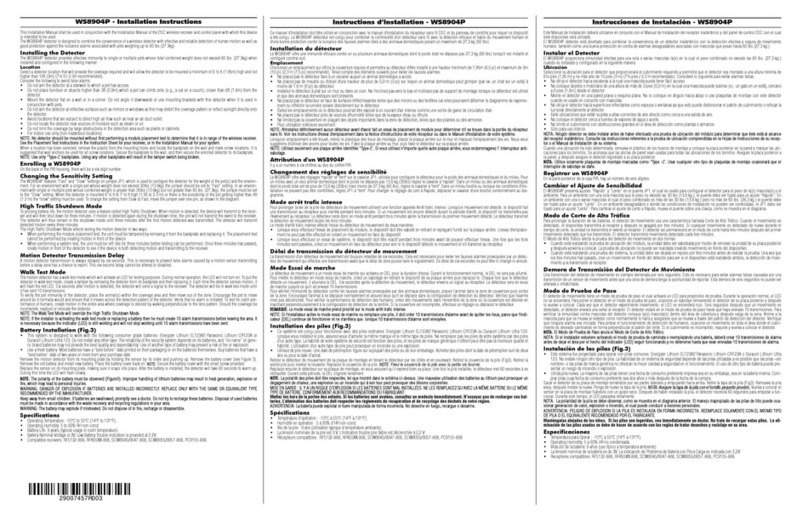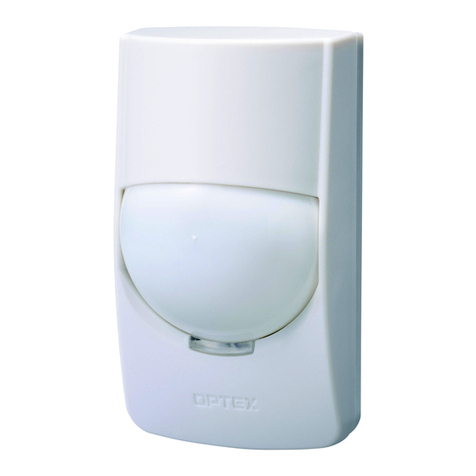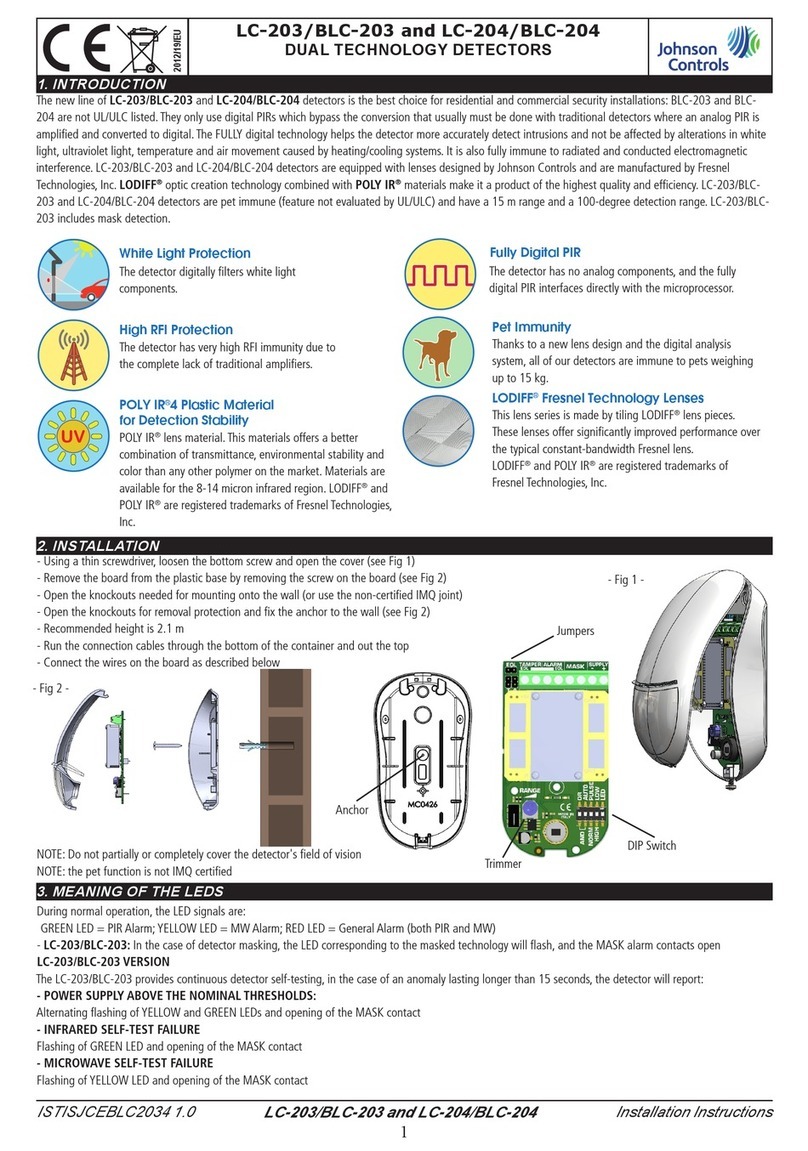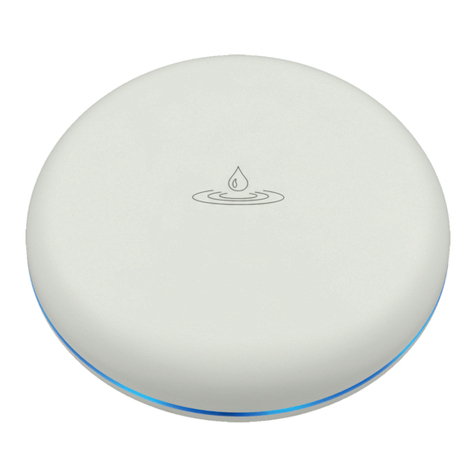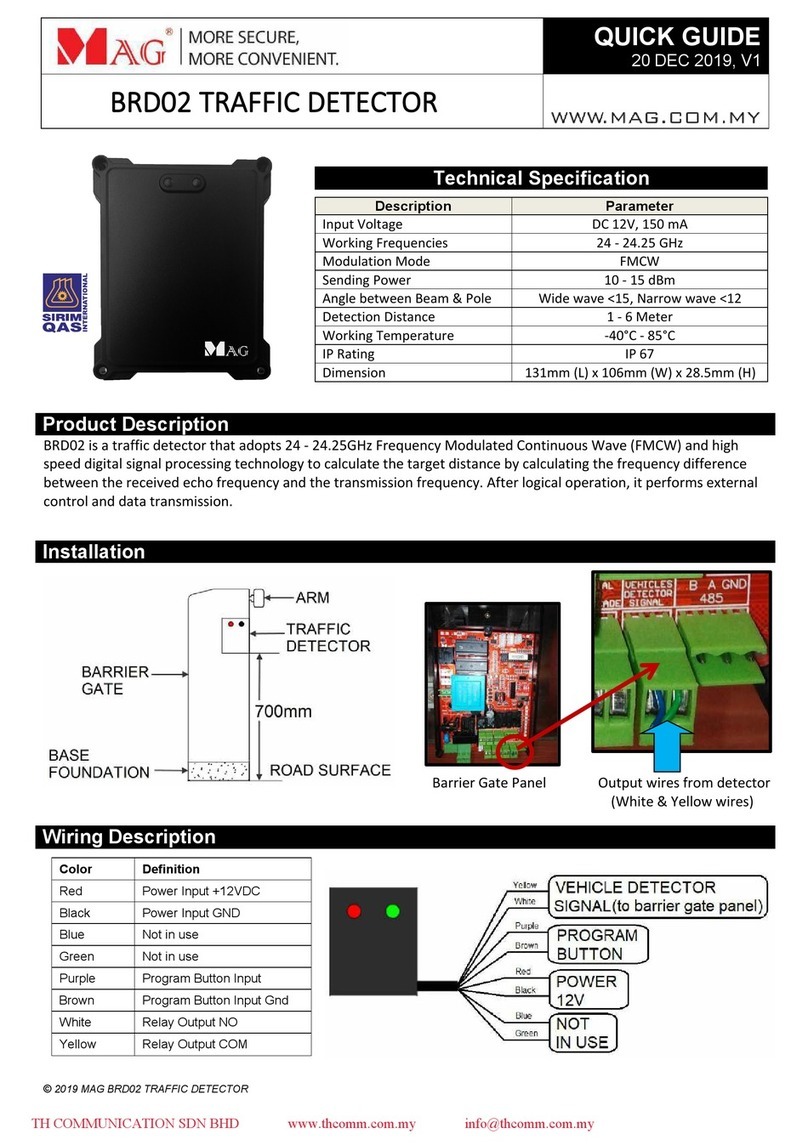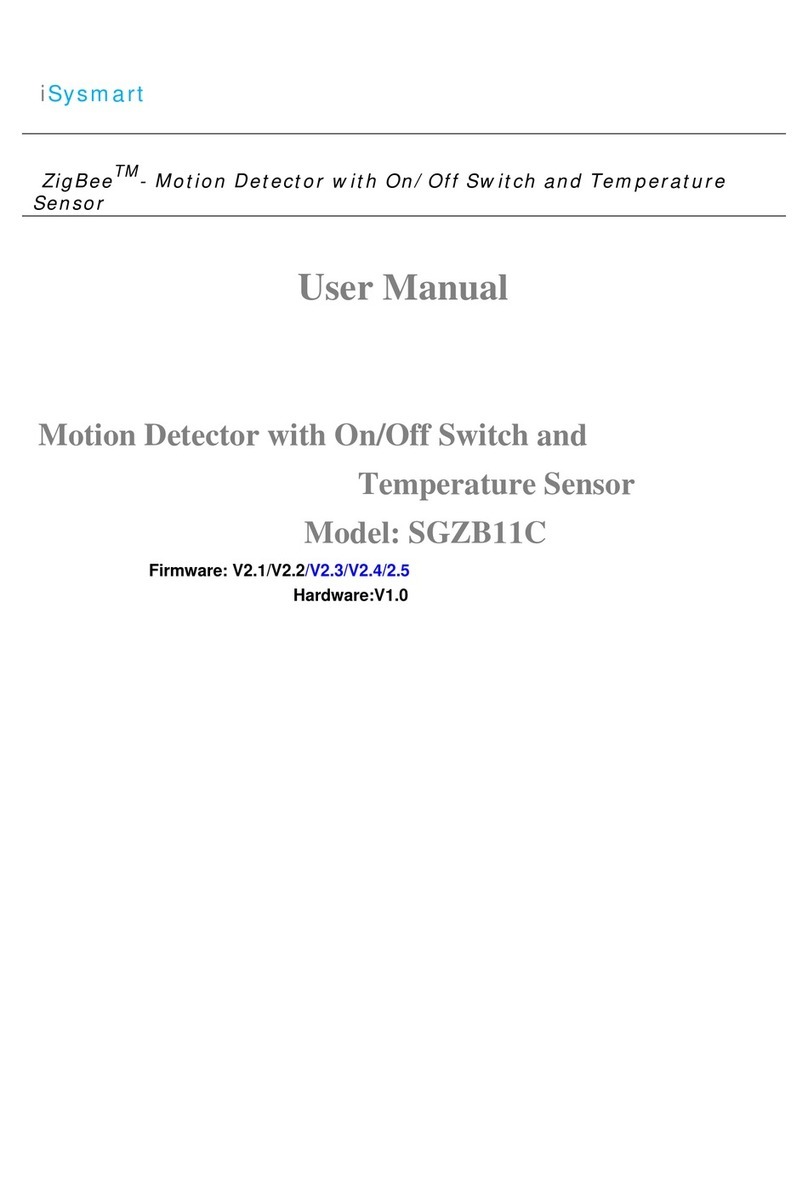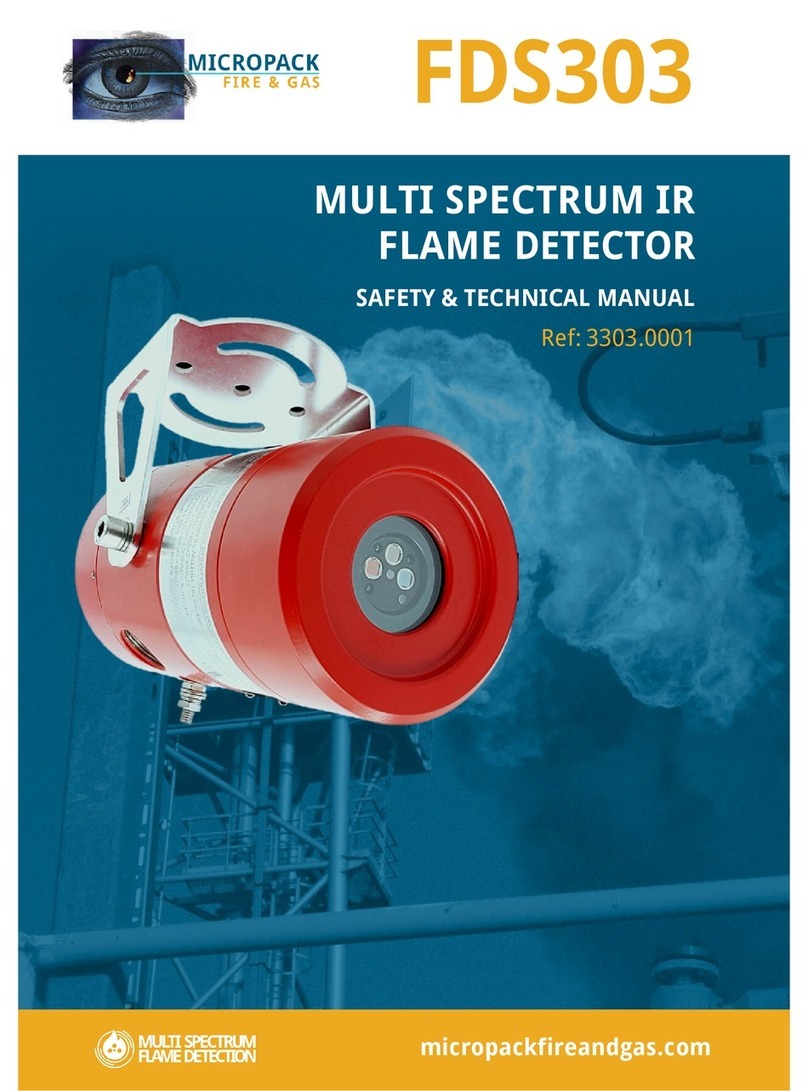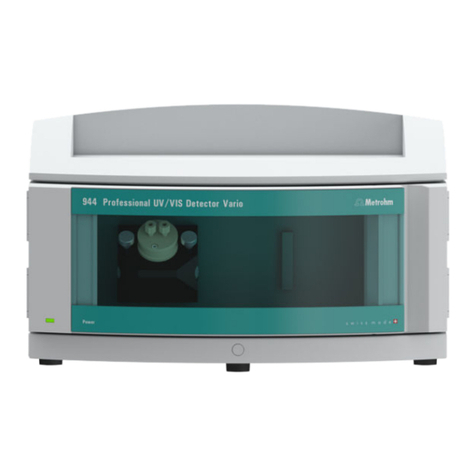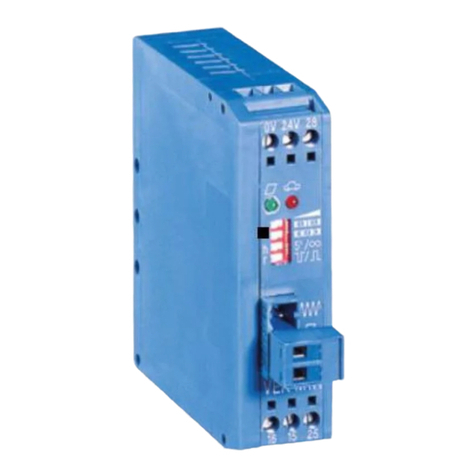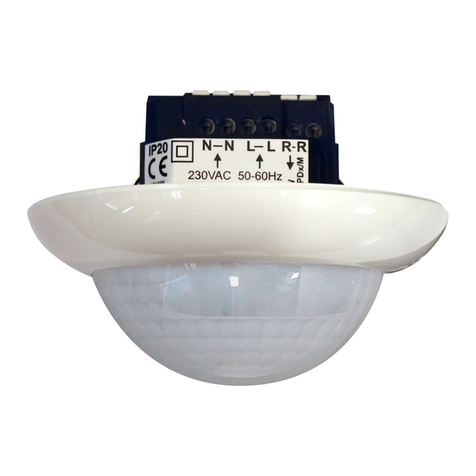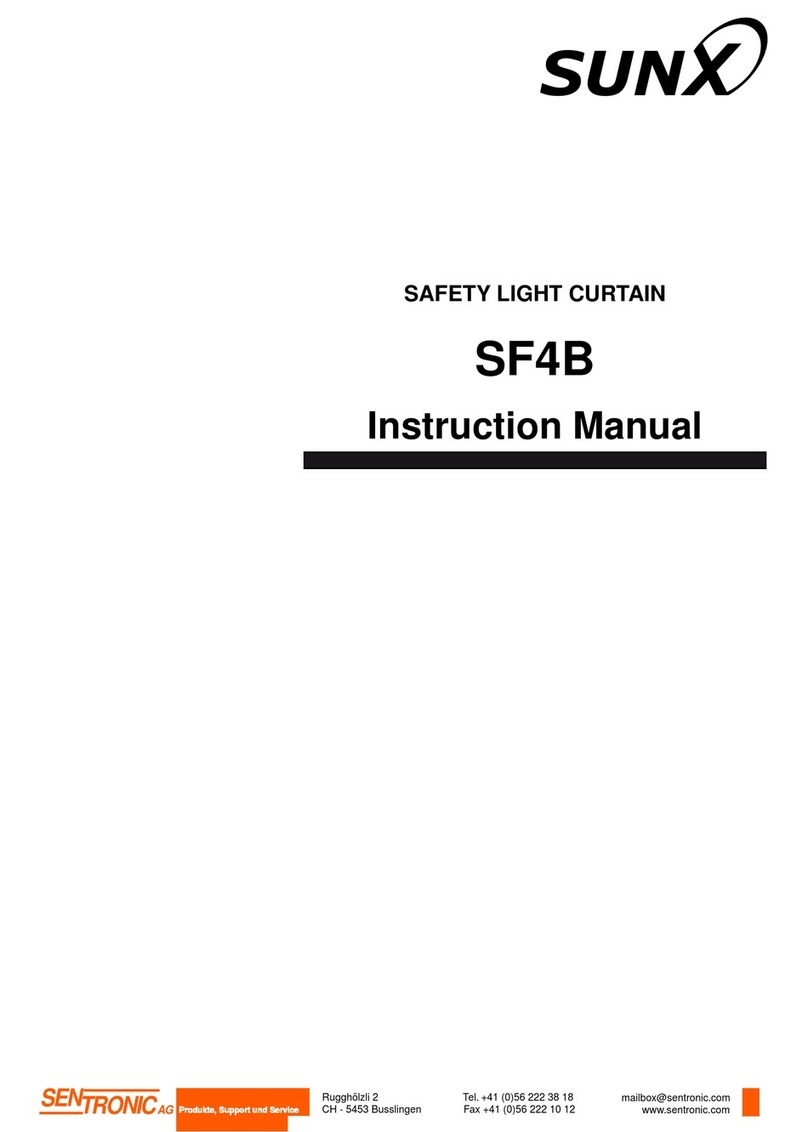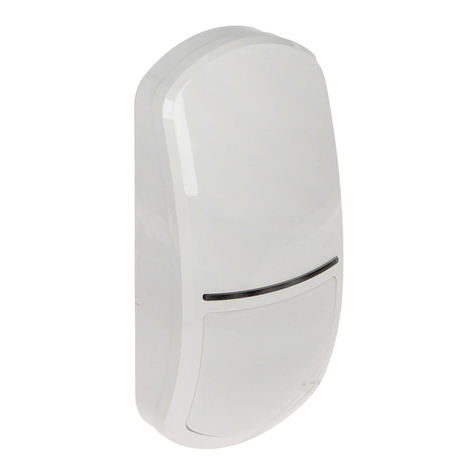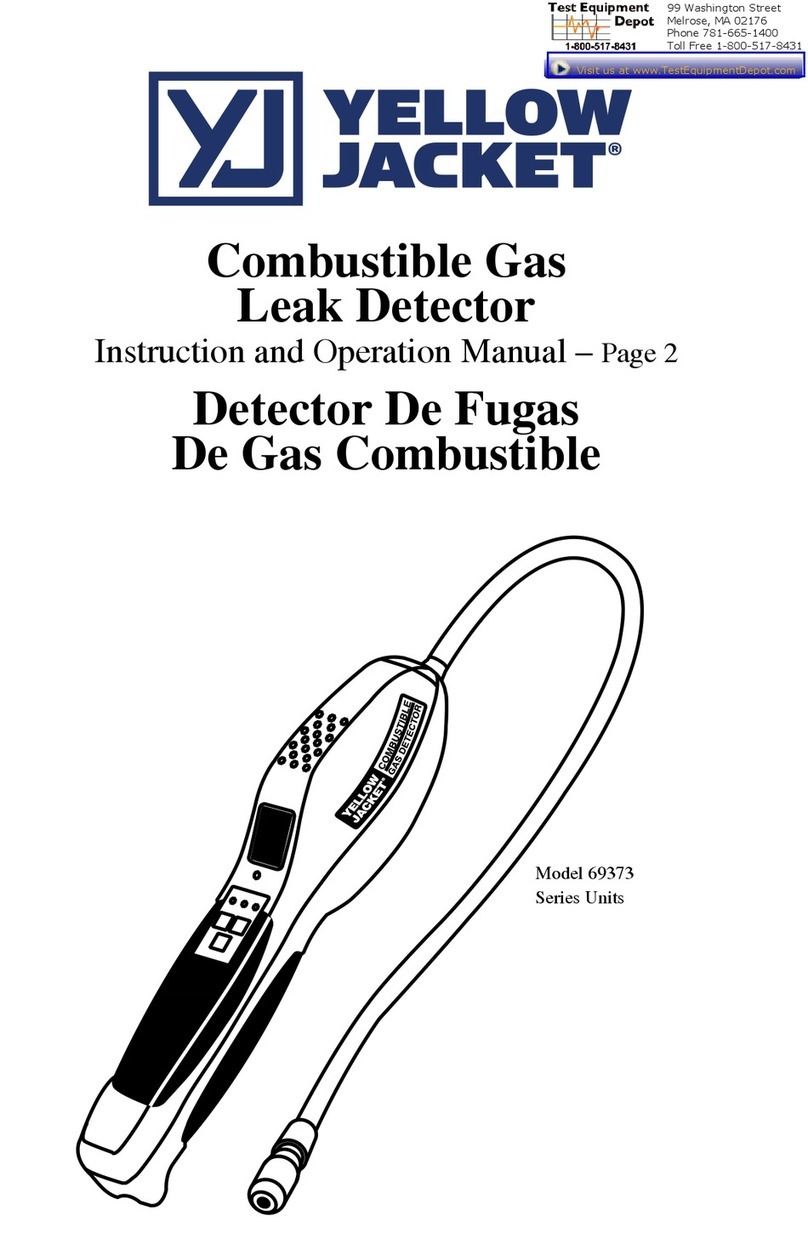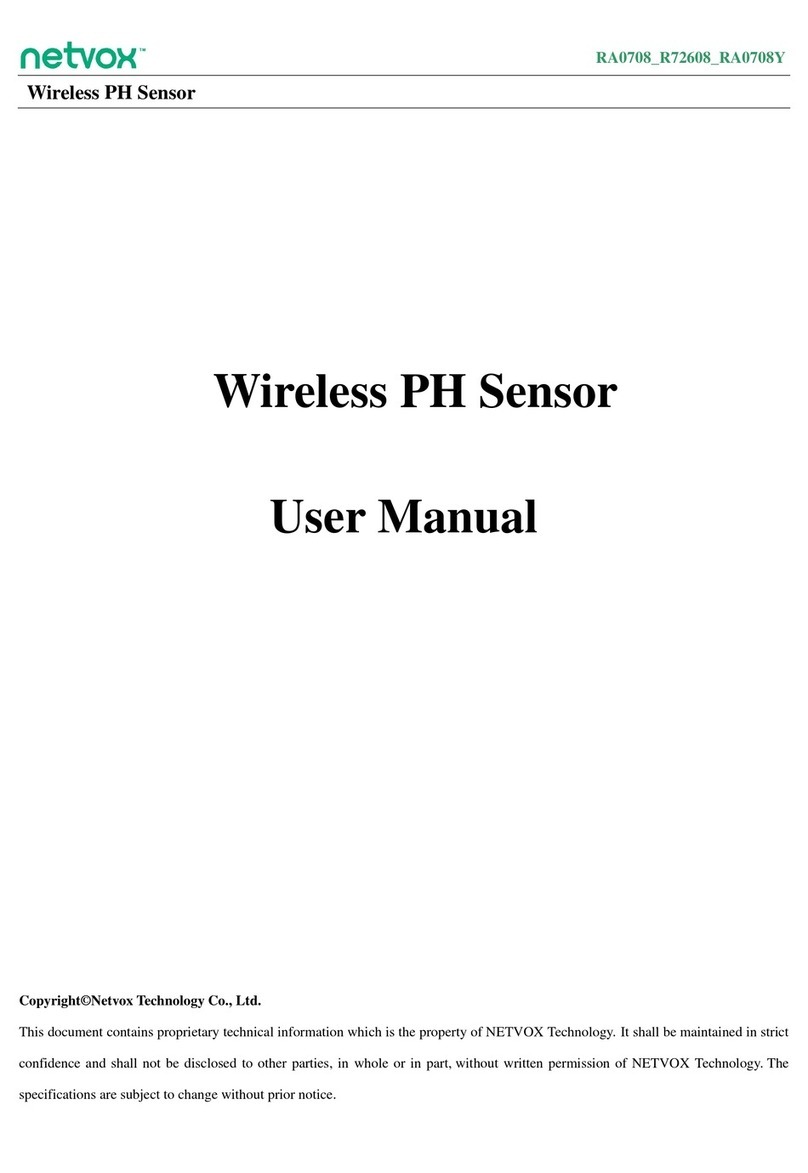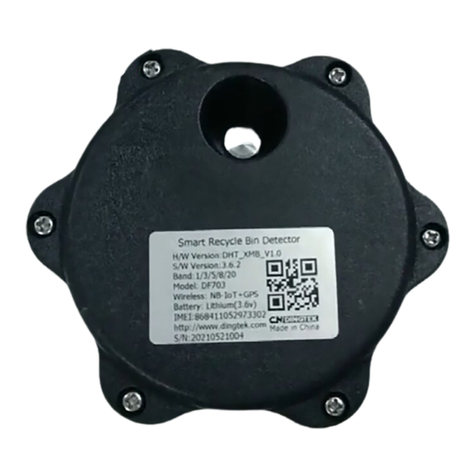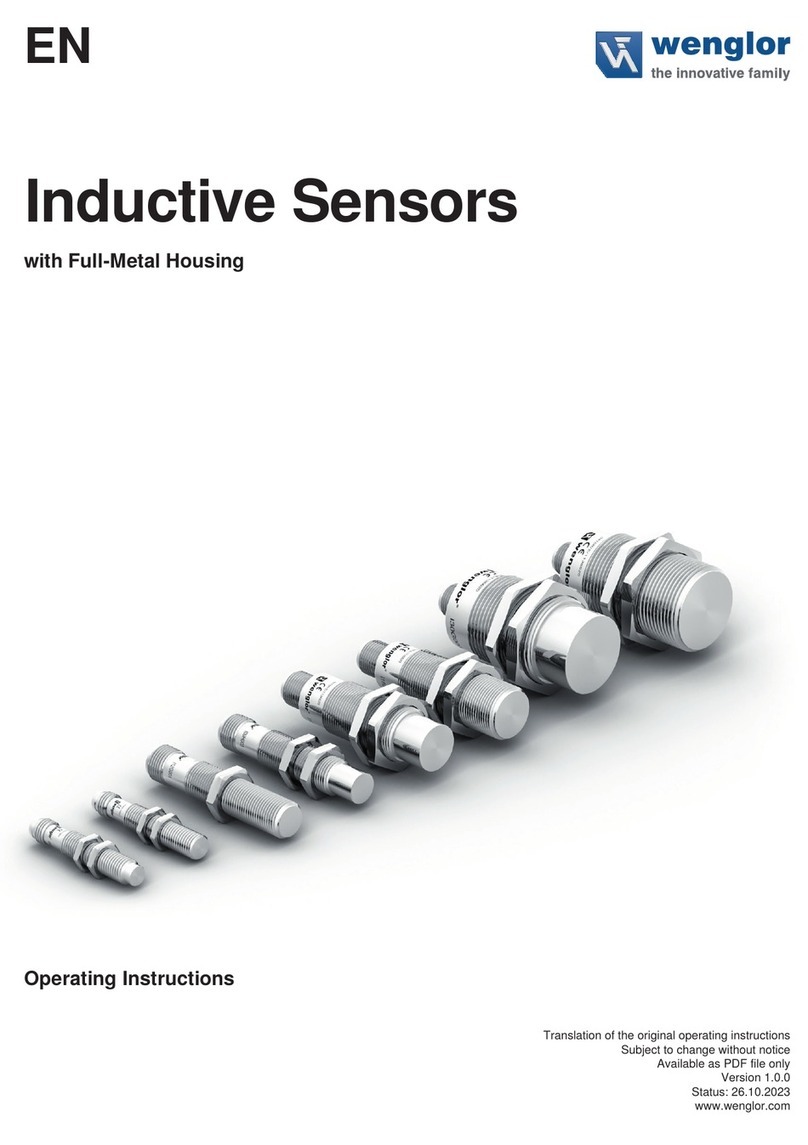SPX RADIODETECTION RD5100 H2O+ User manual

RD5100™H2O+
Precision water and gas industry
pipe locator and transmitter
Operation manual
90/5100H20+OPMAN-ENG/01

RD5100H2O+ Operation Manual
© 2018 Radiodetection Ltd 1
Table of Contents
Section 1 Preface......................................... 2
1.1 Important notices.........................................2
1.2 Compliance..................................................3
1.3 Intellectual property .....................................3
Section 2 Introduction................................. 4
2.1 About this manual........................................4
2.2 About the RD5100H2O+...............................4
2.3 Extended warranty.......................................4
2.4 eCertTM ........................................................4
2.5 Manual outline .............................................4
2.6 Safety..........................................................4
2.7 Training .......................................................5
Section 3 System overview......................... 7
3.1 RD5100H2O+ locator...................................7
3.2 RD5100H2O+ transmitter.............................9
3.3 Using the locator and transmitter menu .......9
Section 4 Operation....................................11
4.1 First use.....................................................11
4.2 Power on / off ............................................14
4.3 Keypad actions & shortcuts .......................14
4.4 Locate modes............................................15
4.5 System setup.............................................15
4.6 Dynamic Overload Protection™.................16
4.7 TruDepth™ measurement .........................16
4.8 StrikeAlert™................................................16
4.9 Backlight....................................................17
4.10 Bluetooth wireless....................................17
4.11 Transmitter power output.........................17
4.12 Transmitter Eco mode..............................17
4.13 Measure mode.........................................18
Section 5 Locating cables and pipes........19
5.1 Frequencies...............................................19
5.2 Locate modes............................................20
5.3 Compass ...................................................21
5.4 Trace.........................................................21
5.5 Sweep and search.....................................21
Section 6 Depth and current readings......23
6.1 TruDepth™................................................23
6.2 Verifying depth measurements ..................24
6.3 Current readings........................................24
Section 7 Locating techniques..................27
7.1 Identifying target utilities ............................27
7.2 Signal & ground connection.......................28
7.3 Double-ended connections........................28
Section 8 Using accessories .....................29
8.1 About accessories .....................................29
8.2 Headphones..............................................29
8.3 Transmitter clamps....................................29
8.4 Sondes......................................................30
Section 9 Current Direction (CD).............. 33
9.1 Understanding CD.....................................33
9.2 CD reset....................................................34
Section 10 Bluetooth wireless connections
..................................................................... 35
10.1 Switching Bluetooth On ...........................35
10.2 Switching Bluetooth off............................35
10.3 Pairing to a transmitter.............................35
10.4 Bluetooth standby mode..........................36
10.5 Troubleshooting.......................................36
Section 11 iLOC ......................................... 38
11.1
Using
iLOC...............................................38
11.2 iLOC functions.........................................38
11.3 SideStep™ ..............................................39
Section 12 Appendices.............................. 40
12.1 Care and maintenance ............................40
12.2 Enhanced Self-Test.................................40
12.3 RD5100 Manager™.................................40
12.4 Warranty and extended warranty.............41
12.5 Upgrading software .................................41
12.6 eCertTM ....................................................41
12.7 List of supported accessories ..................42
12.8 RD5100H2O+ Package part numbers .....45

RD5100H2O+ Operation Manual
2 © 2018 Radiodetection Ltd
Section 1 Preface
Before you begin
Thank you for your interest in Radiodetection’s
RD5100™H2O+ cable and pipe locator.
The RD5100H2O+ delivers the latest in locating
technology in a powerful yet ergonomic and light-weight
design.
Please read this user manual in its entirety before
attempting to use the RD5100H2O+ system.
Radiodetection products, including this manual, are
under continuous development. The information
contained within is accurate at the time of publication;
however the RD5100H2O+, this manual and all its
contents are subject to change.
Radiodetection Limited reserves the right to modify the
product without notice and some product changes may
have taken place after this user manual was published.
Contact your local Radiodetection dealer or visit
www.radiodetection.com for the latest information about
the RD5100H20+ product family, including this manual.
1.1 Important notices
General
The performance of any cable and pipe locator may be
affected when used in close proximity to ferrous materials
such as manhole covers, steel-toe boots, mobile phones
and nearby vehicles. Keep a distance of 1 or 2m from
these objects when taking critical measurements such as
depth and current readings.
This instrument, or family of instruments, will not be
permanently damaged by reasonable electrostatic
discharge and has been tested in accordance with IEC
801-2. However, in extreme cases temporary malfunction
may occur. If this happens, switch off, wait and switch on
again. If the instrument still malfunctions, disconnect the
batteries for a few seconds.
Safety
WARNING: Failure to comply with safety warnings
can cause serious injury or death.
CAUTION: Failure to comply with safety cautions can
result in damage to equipment or property.
This equipment must be used only by suitably qualified
and trained personnel, and only after fully reading this
Operation Manual.
WARNING: Direct connection to live conductors is
POTENTIALLY LETHAL. Direct connections to live
conductors should be attempted by fully qualified
personnel only using the relevant products that allow
connections to energized lines.
WARNING: The transmitter is capable of outputting
potentially lethal voltages. Take care when applying
signals to any pipe or cable and be sure to notify other
technicians who may be working on the line.
WARNING: Reduce audio level before using
headphones to avoid damaging your hearing.
WARNING: This equipment is NOT approved for use
in areas where hazardous gases may be present.
WARNING: Before removing the transmitter battery
pack, switch off the unit and disconnect all cables.
WARNING: The RD5100H2O+ locator will detect
most buried conductors but there are some objects,
including live objects, which do not radiate any detectable
signal. The RD5100H2O+, or any other electromagnetic
locator, cannot detect these objects so proceed with
caution. There are also some live cables which the
RD5100H2O+ will not be able to detect in Power mode.
The RD5100H2O+ does not indicate whether a signal is
from a single cable or from several in close proximity.
CAUTION: The battery cover, the accessory cover and
the headphone cover protect the locator’s sockets from
debris and water ingress. If they get damaged or lost,
contact Radiodetection or your local service
representative for a replacement one.
Batteries
WARNING: Batteries can get hot after prolonged use
at full output power. Take care while replacing or
handling batteries.
WARNING: Do not tamper with, or attempt to
disassemble the battery packs.
CAUTION: If battery failure is suspected return the entire
unit to an authorized repair center for investigation and
repair. Local, national or International Air Transport
Association (IATA) transport regulations may restrict the
shipment of faulty batteries. Check with your courier for
restrictions and best practice guidelines. Your local
Radiodetection representative will be able to direct you to
our authorized repair centers.
WARNING: Exposing the battery to a high
temperature above 60°C (140°F) may activate safety
systems and cause a permanent battery failure.

RD5100H2O+ Operation Manual
© 2018 Radiodetection Ltd 3
Disposal
This symbol on the product, accessories or
literature indicates that the product and its
electronic accessories (for example, charger,
headset and USB cable) must not be treated as
domestic waste, but must be disposed of
professionally. It is your responsibility to dispose of your
waste equipment by handing it over to a designated
collection point for the recycling of waste electrical and
electronic equipment. The separate collection and
recycling of your waste equipment at the time of disposal
will help to conserve natural resources and ensure that it
is recycled in a manner that protects human health and
the environment. For more information about where you
can drop off your waste equipment for recycling, please
contact your local city office, your disposal service or
product supplier.
Please dispose of this device in a manner appropriate to
the relevant legal requirements at the end of its product
life.
Batteries should be disposed of in accordance with your
company’s work practice, and / or the relevant laws or
guidelines in your country or municipality.
1.2 Compliance
EU Compliance
This equipment complies with the following EU
Directives:
RED (Radio Equipment Directive): 2014/53/EU
EMC (Electromagnetic Compatibility Directive):
2014/30/EU
EMF (Electromagnetic Fields Directive):
1999/519/EC
ROHS (Restriction of Hazardous Substances
Directive): 2011/65/EU
WEEE (Waste Electrical and Electronic Equipment
Directive): 2012/19/EU.
FCC Compliance Statement
This equipment complies with Part 15 of the FCC Rules.
Operation is subject to the following two conditions:
The equipment may not cause harmful
interference
The equipment must accept any interference
received, including interference that may cause
undesired operation.
This equipment has been tested and found to comply
with the limits for a Class A digital device pursuant to Part
15 of the FCC Rules.
These limits are designed to provide reasonable
protection against harmful interference when the
equipment is operated in a commercial environment. This
equipment generates, uses, and can radiate radio
frequency energy and, if not installed and used in
accordance with the manufacturer’s instruction manual,
may cause harmful interference with radio
communications. Operation of this equipment in a
residential area is likely to cause harmful interference, in
which case you will be required to correct the
interference at your own expense.
Modifications: Any modifications made to this
equipment not approved by Radiodetection may void the
authority granted to the user by the FCC to operate this
equipment.
Industry Canada Compliance Statements
ICES-003 Class A Notice:
This Class A digital apparatus complies with
Canadian ICES-003.
Avis NMB-003, Classe A:
Cet appareil numérique de la classe A est
conforme à la norme NMB-003 du Canada.
1.3 Intellectual property
© 2018 Radiodetection Ltd. All rights reserved.
Radiodetection is a subsidiary of SPX Corporation. SPX
is a trademark of SPX Corporation, Inc. Radiodetection
and RD5100H2O+ are registered trademarks of
Radiodetection in the United States and/or other
countries.
Trademarks and Notices. The following are trademarks of
Radiodetection: RD5100, SideStep, Dynamic Overload
Protection, eCert, TruDepth, RD Manager, Peak+,
StrikeAlert. The design of the RD5100H2O+ locators and
transmitters has been registered. The design of the 4
chevrons has been registered.
The Bluetooth word, mark and logos are registered
trademarks of Bluetooth Sig, Inc. and any use of such
trademarks by Radiodetection is under license. Windows
and Windows XP are either registered trademarks or
trademarks of Microsoft Corporation in the United States
and / or other countries.
Due to a policy of continued development, we reserve the
right to alter or amend any published specification without
notice. This document may not be copied, reproduced,
transmitted, modified or used, in whole or in part, without
the prior written consent of Radiodetection Ltd.

RD5100H2O+ Operation Manual
4 © 2018 Radiodetection Ltd
Section 2 Introduction
2.1 About this manual
This manual provides cable and pipe survey
professionals with comprehensive operating instructions
for the RD5100™H2O+ locator and transmitter system.
Before operating the RD5100H2O+ system it is very
important that you read this manual, noting all safety
warnings, cautions and procedures.
Additional documentation
The full product specification and RD5100 Manager
manual are available to download from
www.radiodetection.com.
2.2 About the RD5100H
2
O+
The RD5100H2O+ locator is ergonomically designed to
provide the operator with a balanced, light weight tool
that encourages extended use in most environments.
A wide range of accessories are available to enhance the
performance and to add extra functionality.
For more information about the Precision Locate
Accessories Range, visit:
www.radiodetection.com/accessories
2.3 Extended warranty
RD5100H2O+ locators and transmitters are covered by a
one year warranty as standard.
Users can extend the warranty period to a total of three
years by registering their products (locators and
transmitters) within three months from purchase.
Registration is performed using the RD5100 Manager PC
software. See Section 12.3 for further details.
From time to time Radiodetection may release new
software to improve the performance or add new
functionality to products. By registering the user will have
the option of subscribing to e-mail alerts advising about
any new software and special offers related to its product
range.
Users can opt out any time from receiving software and
technical notifications or just from receiving marketing
material.
2.4 eCert
TM
The RD5100H2O+ has been designed so that it does not
require regular calibration. However, as with all safety
equipment, it is recommended that a service should be
carried out at least once a year either at Radiodetection’s
service center or an approved Radiodetection service
center. Alternatively eCertTM may be used to validate the
calibration of the RD5100H2O+ locator.
eCert is a novel Radiodetection technique that allows the
user to validate the original factory calibration of the
RD5100H2O+ locator, providing the user with the
confidence that the locator continues to meet its original
factory calibration. eCert also carries out a functional test
on the locator providing the user with the confidence that
the locator continues to provide the same performance
as it did when it first left the factory. eCert can be carried
out on site without the need to return the locator to a
service center, saving time and expense. Each time the
locator passes eCert, the user can view or print a dated
eCert validation certificate.
A detailed explanation of eCert is provided in Section
12.6.
2.5 Manual outline
Section 1 includes an overview of safety procedures and
notices. Review them before moving on to Section 2 and
the rest of this manual.
Section 2 provides an introduction to the RD5100H2O+.
Section 3 provides an overview of the RD5100H2O+
system with annotated diagrams of the locator and
transmitter.
Section 4 introduces basic setup and operation using the
RD5100H2O+ locator’s menu system.
Section 5 introduces the theory and practice of cable and
pipe location using the RD5100H2O+ locator and
transmitter.
Section 6 introduces depth and current readings.
Section 7 provides general locating tips.
Section 8 introduces the range of accessories that are
compatible with the RD5100H2O+ system.
Section 9 includes several appendices with reference
material and other technical information.
2.6 Safety
Read this manual in its entirety before attempting to
operate the RD5100H2O+ locator or transmitter. Note all
safety notices in the preface and throughout this manual.
You are responsible for determining whether the
conditions are suitable for using this device. Always carry
out a risk assessment of the site to be inspected.

RD5100H2O+ Operation Manual
© 2018 Radiodetection Ltd 5
Follow your company and national safety procedures and
or requirements when operating this equipment in any
environment or workplace. If you are unsure what
policies or procedures apply, contact your company or
site’s occupational health and safety officer or your local
government for more information.
Do not use this equipment if you suspect that any
component or accessory is damaged or faulty.
Before inserting the earth stake into the ground, ensure
there are no shallow cables or services that could be
damaged by the earth stake.
Use authorized accessories only. Incompatible
accessories may damage the equipment or give
inaccurate readings.
If you intend to uncover a sub-surface utility by digging,
you must follow your company, region and country’s
codes of practice for excavation.
Keep this equipment clean and arrange for regular
services with an authorized Radiodetection service
center. More information can be found in the Appendix or
from your local Radiodetection representative.
It is important to regularly clean and sanitize products
which may become contaminated through contact with
foul water or other contaminants.
Headphone use: you need to remain alert to traffic and
other hazards that are normally heard outdoors. Always
turn the volume down before plugging headphones into
an audio source and use only the minimum level,
necessary to take your measurements. Excessive
exposure to loud sounds can cause hearing damage.
Do not attempt to open or dismantle any part of this
equipment unless directed specifically by this manual.
Doing so may render the equipment faulty and may void
the manufacturer’s warranty.
You are responsible for determining whether you
consider the measurement results to be valid and for any
conclusions that are reached or any measures that are
taken as a result thereof. Radiodetection can neither
guarantee the validity of any measuring results nor can
we accept liability for any such results. We are on no
account able to accept liability for any damage which
may be caused as a consequence of the use of these
results. Please see the Standard Warranty Terms
enclosed with the product for further information.
2.7 Training
Radiodetection provides training services for most
Radiodetection products. Our qualified instructors will
train equipment operators or other personnel at your
preferred location or at Radiodetection headquarters.
For more information go to www.radiodetection.com or
contact your local Radiodetection representative.

RD5100H2O+ Operation Manual
6 © 2018 Radiodetection Ltd
Figure 3-1: RD5100H2O+ locator

RD5100H2O+ Operation Manual
© 2018 Radiodetection Ltd 7
Section 3 System overview
3.1 RD5100H
2
O+ locator
Refer to Figure 3-1.
Locator features
1 Keypad.
2 Bluetooth®module antenna.
3 Liquid Crystal Display (LCD) with backlight.
4 Battery compartment.
NOTE: The RD5100H2O+ is supplied with non-
rechargeable D type batteries. It is possible to use a
Li-Ion rechargeable battery pack by purchasing the
optional battery compartment from Radiodetection.
5 Headphone jack.
6 Accessory socket.
7 Mini USB-B socket (Internal to battery compartment).
8 Speaker.
Locator keypad
9 Power key : Switches the unit on and off. Provides
access to the set-up options menu.
10 Up arrow key : Increase gain (in power and radio
modes).
11 Backlight sensor: Provides automatic control of the
LCD display backlight.
12 Transmit key : Send an iLOC command to a
paired transmitter.
13 Target Position Indicator (TPI) key : Turn TPI
mode On/Off.
14 Down arrow key : Decrease gain (in power and
radio modes).
15 Frequency key : Scroll through frequencies from
low to high.
Locator display icons
16 Battery icon: Indicates the battery level.
17 Signal strength bargraph with peak marker.
18 Volume level.
19 Current direction arrows.
20 Null / Proportional Left/Right arrows: Indicates the
location of the target relative to the locator.
21 Signal strength readout.
22 Antenna mode icon:
Indicates mode selection (Guidance / Peak).
23 Sonde icon: Indicates that a sonde signal source is
selected.
24 Transmitter communication status –confirms
successful iLOC™ communication.
25 Transmitter standby indicator.
26 Line icon: Indicates that a line signal source is
selected.
27 Depth: Indication of depth reading.
28 Bluetooth status icon: A flashing icon means pairing
is in progress. A solid icon indicates a connection is
active.
29 Compass: Displays the direction of the cable or pipe
relative to the locator.
30 Measured values: Frequency or current readout
(mode dependent).
31 Current Detection (CD) mode icon.
32 Power mode icon.
33 Radio mode icon.
34 Sensitivity readout.

RD5100H2O+ Operation Manual
8 © 2018 Radiodetection Ltd
Figure 3-2: RD5100H2O+Tx transmitter

RD5100H2O+ Operation Manual
© 2018 Radiodetection Ltd 9
3.2 RD5100H
2
O+ transmitter
Transmitter features
1 LCD.
2 Keypad.
3 Bluetooth® module.
4 Removable accessory tray.
5 Side support.
6 Speaker (internal).
7 D-cells battery holder.
8 Optional Lithium-Ion rechargeable battery pack.
Accessory tray contents
9 Earth stake: Spiral earth stake.
10 Magnet: Hi-strength magnet with M4 eyebolt.
11 Earth lead: Earth spool 10m.
12 Direct connection lead: Transmitter direct connection
lead.
Transmitter keypad
13 Power key : Switches the unit on and off.
Opens the transmitter menu.
14 Frequency key : Selects frequency.
Menu navigation key.
15 Measure key : Used to take voltage and
impedance measurements.
Opens a sub menu.
16 Down arrow key: Adjusts the output signal level.
Scrolls through the menu options.
17 Up arrow key: Adjusts the output signal level.
Scrolls through the menu options.
Transmitter screen icons
18 Battery icon: Indicates the battery level.
19 Standby icon: Appears when the transmitter is in
Standby Mode.
20 Output level: Displays an indication of transmitter
output power as a bargraph.
21 Clamp icon: Indicates when a signal clamp or other
accessory is connected.
22 Bluetooth®icon: Indicates status of Bluetooth.
23 Voltage warning indicator: Indicates that the
transmitter is outputting potentially hazardous voltage
levels.
24 Volume icon: Displays the volume level.
25 Output power level: Displays the output power in
watts or as a percentage.
26 Resistance measurements: Displays the resistance
or current in Direct Connection mode.
27 Alphanumeric description of selected operation
mode.
28 Accessory or Measurement indicators: Indicates if an
accessory is connected or if measure mode is active.
29 Induction indicator: Appears when the transmitter is
in Induction mode.
30 CD mode: Indicates that the transmitter is in Current
Detection mode.
31 A-Frame: Indicates when the transmitter is in Fault-
Find Mode.
32 DC icon: Appears when the transmitter is powered
from a DC source.
3.3 Using the locator and
transmitter menu
The RD5100H2O+ locator and transmitter menus allow
you to select or change system options. Once entered,
the menu is navigated using the arrow keys. Navigation
is consistent on both the transmitter and the locator. In
the menu the options will appear in the bottom left-hand
corner of the display.
Note. When you browse the locator menu, the and
keys act as left and right arrows. When browsing the
transmitter menu the and keys act as left and right
arrows. The right arrow enters a submenu and the left
arrow selects the option and returns to the previous
menu.
Navigating the locator menu
1 Press the key to enter the menu.
2 Use the or keys to scroll through the menu
options.
3 Press the key to enter the option's submenu.
4 Use the or arrows to scroll through the
submenu options.
5 Press the key to make a selection and return to
the previous menu.
6 Press the key to return to the main operation
screen.

RD5100H2O+ Operation Manual
10 © 2018 Radiodetection Ltd
Locator menu options
Table 3.1: Locator menu options
VOL
Adjust the speaker volume from 0 (mute) to
3 (loudest).
BT
Configure Bluetooth®options. Parameters
include:
ON - Enable Bluetooth®
OFF - Disable Bluetooth®
RESET - Resets the Bluetooth®pairing
PAIR - Pairs the locator with the
transmitter
STDBY - Places the locator in standby.
CDR
Performs a Current Direction (CD) Reset
(Alternatively press and hold the key
when in CD mode).
INFO
Access information options. Parameters
include:
ECERT - Displays the last eCert test
date
TEST - Run a Self-Test
CAL - Display the date of the most
recent service recalibration.
LANG
Select menu language.
FREQ
Enable or disable individual frequencies.
ALERT
Enable or disable StrikeAlert.
COMPA
Enable or disable display of the Compass
feature.
Navigating the transmitter menu
1 Press the key to enter the menu.
2 Use the or keys to scroll through the menu
options.
3 Press the key to enter the option’s submenu.
4 Use the or keys to scroll through the submenu
options.
5 Press the key to confirm selection and return to
the previous level or exit the menu.
6 Press the key to return to the main operation
screen.
Transmitter menu options
Table 3.2: Transmitter menu options
VOL
Adjust the speaker volume from 0 (mute)
to 3 (loudest).
FREQ
Enable or disable individual frequencies.
BOOST
Boost transmitter output for a specified
period of time (in minutes).
LANG
Select menu language.
OPT F
Run SideStepauto™ to auto-select a
locate frequency for the connected utility.
BATT
Set battery type: Alkaline, NiMH or Li-Ion.
Select Eco mode (alkaline batteries only).
MAX P
Set the transmitter to output its maximum
wattage.
MODEL
Match the transmitter setting to the model
of your locator.
MAX V
Set the output voltage to maximum (90V).
BT
Configure Bluetooth®options. Parameters
include:
ON - Enable Bluetooth®
OFF - Disable Bluetooth®
RESET - Resets the Bluetooth®pairing
PAIR - Pairs the locator with the
transmitter
STDBY - Places the locator in standby.

RD5100H2O+ Operation Manual
© 2018 Radiodetection Ltd 11
Section 4 Operation
4.1 First use
Power options
RD5100H2O+ systems are shipped as standard
configured to use non rechargeable D-cell alkaline
batteries.
Both the locator and transmitter can also be powered
using good quality rechargeable D-cell NiMH batteries. In
addition the locator and transmitter can be powered
respectively by optional accessory NiMH and Li-Ion
rechargeable battery packs. It’s important to set the
correct battery chemistry in the locator to optimize
performance, see Section 4.5.
Transmitters can also be powered using optional
accessory mains or vehicle power adapters.
Inserting batteries
RD5100H2O+ systems are shipped with non-
rechargeable D-cell battery trays. Suitable alkaline or
NiMH batteries should be fitted in the battery
compartment before your first use.
On the Locator:
To fit the D-cell batteries in the locator, unlatch the
battery compartment as shown in Figure 4.1.
Figure 4.1: Open the battery compartment
Insert two good quality D-cell batteries as shown in
Figure 4.2.
NOTE: Pay attention to the polarity of the cells when
inserting them in the battery tray.
Close the battery compartment.
Figure 4.2: Inserting locator batteries
On the transmitter:
To fit the D-cell batteries in the transmitter, unlatch the
accessory tray. The battery compartment is located
underneath the transmitter body. Use the turnkey to
unlatch the battery compartment. Insert eight D-Cell
Alkaline or NiMH batteries.
Figure 4.3: D-cell battery trays
Battery status
The locator and transmitter displays provide a battery
level indicator (Refer to the illustrations in Section 3).
When battery replacement is necessary, the display
shows a flashing battery icon.
NOTE: Prolonged use of high power output on the
transmitter will reduce battery life.
Removing / fitting battery packs
Locator battery pack:
1 Open the battery compartment using the release
catch (Refer to Figure 4.1).

RD5100H2O+ Operation Manual
12 © 2018 Radiodetection Ltd
2 If using a Li-Ion battery pack un-plug the lead
connector (Refer to Figure 4.7).
3 Lift the accessory cover slightly and press the battery
retaining latch inwards.
Figure 4.4: Press the retaining latch inwards
4 Rotate the battery pack away and up from the latch.
5 Repeat on the other side to release the battery pack
completely then lift the battery pack away.
Figure 4.5: Repeat then lift the battery pack away
To fit a new battery, lift both accessory covers slightly,
then gently push the replacement pack into place until it
clicks on both sides, then close the battery pack.
Figure 4.6: Installing a new battery pack
If using the Li-ion battery pack, plug the lead into the
battery connector (Refer to Figure 4.7).
Figure 4.7: Connecting the Li Ion lead
NOTE: Fully charge your lithium-ion battery pack before
its first use.
Transmitter battery pack:
1 Unlatch then remove the accessory tray.

RD5100H2O+ Operation Manual
© 2018 Radiodetection Ltd 13
Figure 4.8: Release then remove the accessory tray
2 Turn the release catch, then open the battery
compartment.
3 Release the retaining catch (Refer to Figure 4.10) by
pressing gently, then lift the battery pack away.
4 Line up the battery pack clips with the corresponding
recesses on the transmitter body and press into
place (Refer to Figure 4.11).
5 Close the battery pack, turn the retaining latch and
replace the accessory tray.
Figure 4.9: Opening the battery compartment
Figure 4.10: Press the release catch and lift the battery pack away
Figure 4.11: Line up the battery pack and press into position
Charging the lithium ion packs
WARNING: Do not heat the rechargeable battery
pack above 45°C (113°F) as this will damage the
battery’s thermal fuses.
Locator Li-Ion battery pack
To recharge the locator battery pack, connect the battery
charger to the DC input connector on the front of the
battery pack.

RD5100H2O+ Operation Manual
14 © 2018 Radiodetection Ltd
Figure 4.12 - Charging the locator Li-ion battery pack
Transmitter Li-Ion battery pack
To recharge the battery pack, remove the pack from the
transmitter and connect the transmitter battery charger.
Figure 4.13 - Charging the transmitter Li-Ion battery pack
For more information about recharging batteries see the
instructions that came with your charger.
4.2 Power on / off
Switch the locator or transmitter on by pressing the
key.
To switch the locator or transmitter off, press and hold
the key until the screen blanks off.
NOTE. The locator will automatically power off after 5
minutes if no keys are pressed.
4.3 Keypad actions & shortcuts
Locator key actions
Table 4.1 - Locator key actions
Key
Short press
Long press
Enter the menu
Switch power off
Scroll through locate
frequencies from low to
high
-
When using active
frequencies:
Turn Target Position
Indicator (TPI)
ON/OFF.
-
Increase and decrease
gain.
RD5100H2O+
automatically sets gain
to mid-point when
pressed
Rapidly increase and
decrease gain steps
in 1dB increments
Send iLOC command
to a paired transmitter
Enter the Transmitter
power setting for use
over iLOC

RD5100H2O+ Operation Manual
© 2018 Radiodetection Ltd 15
Transmitter key actions
Table 4.2 - Transmitter key actions
Key
Short press
Long press
Enter the menu
Switch power off
Scroll through locate
frequencies from low to
high
-
Take voltage and
impedance
measurements using
selected frequency
Take voltage and
impedance
measurements at a
standardized frequency
Adjusts the output
signal
Select standby /
maximum standard
power
NOTE: to scroll through frequencies from high to low,
hold while pressing the button (applies to both
locators and transmitters).
4.4 Locate modes
The RD5100H2O+ locator supports automatic selection of
Guidance and Peak modes to suit the particular
application or the local environment. The locator switches
to Guidance mode when an active frequency is selected
and Peak mode when a passive frequency is selected.
PEAK: For accurate locating, the Peak bargraph
provides a visual readout of the signal strength.
The Peak signal is found directly over the buried
utility (Peak mode is automatically selected in
Power or Radio modes).
GUIDANCE: Proportional arrows and a
switchable ballistic directional ‘needle’ (TPI)
combine with audio left/right indication for rapidly
tracing the general path of a buried utility.
Switch the TPI ON/OFF by holding the key.
Guidance mode is automatically selected with
active frequencies which include: 512Hz/640Hz,
4096Hz, 8kHz, 9.8kHz, 33kHz, 65kHz, 83kHz
and 131kHz.
For more information on selection of locator modes to
assist with cable and pipe location, refer to Section 5.2.
4.5 System setup
The RD5100H2O+ locator and transmitter settings can be
accessed via the menu. Once in the menu it is possible
to change settings according to your personal
preferences and operating requirements. Some
examples of setting changes are shown below.
Refer to the locator and transmitter menu options (Table
3.2) for more information.
NOTE: These procedures refer to both the transmitter
and locator unless stated otherwise.
Before changing settings, ensure the locator or
transmitter is switched on by pressing the key for two
seconds.
Language
The locator and transmitter support a number of
languages. You can specify your preferred language
using the menu system.
To select your preferred menu language:
1 Press the key to enter the menu.
2 Scroll to the LANG menu using the or keys.
3 Press the key (on the locator) or the key (on
the transmitter) to enter the LANG menu.
4 Scroll through the language options using the or
keys.
5 Press the key to accept your selection and return
to the main menu.
6 Press the key to return to the main operation
screen.
Battery type
RD5100H2O+ locators and transmitters support Lithium-
Ion, Alkaline or Nickel Metal Hydride batteries.
The RD5100H2O+ locator automatically adjusts to the
battery type used.
Set the RD5100H2O+Tx transmitter battery type to match
the currently installed type. This is to ensure optimal
performance and correct battery level indication.
To set the battery type on the RD5100H2O+Tx:
1 Press the key to enter the menu.
2 Scroll to the BATT menu using the or arrows.
3 Press the key on the transmitter to enter the
BATT menu.
4 Scroll through the battery options using the or
keys.
5 Press the key to accept your selection and return
to the main menu.
6 Press the key to return to the main operation
screen.

RD5100H2O+ Operation Manual
16 © 2018 Radiodetection Ltd
Power network frequency
Locator units are available to purchase with either 50Hz
or 60Hz. This parameter is not customer configurable.
Measurement units
Locator units are available to purchase with either Metric
or Imperial (USA customary) units. This parameter is not
customer configurable.
Enabling / disabling frequencies
The locator and transmitter support a wide range of
frequencies and there may be times when some of these
frequencies are not used. It is possible to quickly enable
or disable frequencies using the menu system.
To enable or disable frequencies:
1 Press the key to enter the menu.
2 Scroll to the FREQ menu using the or keys.
3 Press the key (on the locator) or the key (on
the transmitter) to enter the FREQ menu.
4 Scroll through the frequency options using the or
keys.
5 Press the key (on the locator) or the key (on
the transmitter) to enter the frequency.
6 Scroll to OFF or ON using the or keys.
7 Press the key to accept your selection and return
to frequency menu.
8 If you wish to make any further changes follow steps
4 to 6. If you do not wish to make any further
changes press the key twice to return to the main
operation screen.
Volume control
The transmitter and locator feature an internal speaker to
provide critical warnings and assist with cable and pipe
location.
To adjust audio level:
WARNING: Muting audio on the locator will disable
the StrikeAlert audio alarm.
1 Press the key to enter the menu.
2 Scroll to the VOL menu the or arrows.
3 Press the key (locator) or the key (transmitter)
to enter the VOL menu.
4 Scroll through the volume options using the or
keys.
5 Press the key to accept your selection and return
to the main menu.
6 Press the key to return to the main operation
screen.
4.6 Dynamic Overload
Protection™
Dynamic Overload Protection™(DOP) allows you to
locate accurately in areas with high levels of
electromagnetic interference, such as sub-stations and
beneath high-voltage transmission lines. DOP works by
disregarding signal spikes that would otherwise
overwhelm the RD5100H2O+ locator’s digital signal
processor. DOP is an integrated feature of all
RD5100H2O+ locators. No action is required by the user.
NOTE: In cases of high levels of electromagnetic
interference, the DOP will not be able to prevent the
RD5100H2O+ from becoming overloaded. If the
RD5100H2O+ becomes overloaded, users will be alerted
by a flashing mode icon. Both the depth and current
measurements will be disabled in the event of an
overload.
4.7 TruDepth™ measurement
The RD5100H2O+ locator uses TruDepth™to measure
depth automatically when a good quality reading can be
assured.
NOTE: TruDepth only indicates a locate depth when:
The locator is correctly oriented above the target
line, cable or sonde
The local signal conditions are assessed as be
good enough to ensure an accurate reading.
To help you orientate the locator correctly, you can use
the locator’s compass feature on the screen.
Depth measurement values are displayed in either metric
or imperial units which are factory configured.
For more information on measuring depth, refer to
Section 6.
4.8 StrikeAlert
™
StrikeAlert™detects the possible presence of shallow
utilities, and warns the operator with a series of flashing
asterisks on the display and an audible alarm,
characterized by a rapid warbling sound.
StrikeAlert will activate in Power, Active transmit and
sonde locate modes.
RD5100H2O+ locators are shipped with StrikeAlert
enabled by default; this can be disabled by accessing the

RD5100H2O+ Operation Manual
© 2018 Radiodetection Ltd 17
StrikeAlert (‘ALERT’) menu and setting StrikeAlert to
OFF.
StrikeAlert can also be disabled using the RD5100
Manager PC software. Refer to the RD5100 Manager
operation manual for further information.
WARNING: Muting audio on the locator will disable
StrikeAlert Audio alarm.
4.9 Backlight
The transmitter and locator feature a backlight to improve
LCD visibility when required. The locator’s backlight is
controlled by an ambient light sensor and does not
require adjustment by the user.
The transmitter’s LCD backlight is activated whenever
you press a key. The backlight will automatically switch
off after a few minutes.
4.10 Bluetooth wireless
RD5100H2O+ locators feature a Bluetooth wireless
module as standard, providing the ability to connect to a
RD5100H2O+ Tx transmitter.
Refer to Section 12 for further information about Bluetooth
wireless connections and how to pair your devices.
NOTE: The RD5100H2O+ locator wireless features may
be subject to national and or local regulations. Consult
your local authorities for more information.
WARNING! Do not attempt any wireless connection in
areas where such technology is considered hazardous.
This may include: petrochemical facilities, medical
facilities or around navigation equipment.
4.11 Transmitter power output
The transmitter supports several power output modes to
help you select the optimal settings for your requirements
whilst helping to prolong battery life.
Adjusting power output
To adjust the power output:
1 Press the or keys to increase or decrease
power output.
Boost
Boost allows the transmitter to output its maximum output
power. Boost mode can be set to operate for a specified
period of time.
To configure boost:
1 Press the key to enter the menu.
2 Scroll to the BOOST menu using the or keys.
3 Press the key to enter the BOOST menu.
4 Set the BOOST duration using the or keys.
You can choose 5, 10, 15 and 20 minute periods or
ON for continuous operation.
5 Press the key to accept your changes and exit the
BOOST menu.
6 Press the key to exit the menu.
To enable boost:
1 First configure the boost duration using the
procedure above.
2 Press and hold the key until BOOST appears on
the transmitter LCD.
3 The transmitter will automatically exit boost mode
after the selected duration.
To disable boost:
1 Press the key to disable boost.
4.12 Transmitter Eco mode
When using alkaline D-Cells in the transmitter you can
extend the effective use of the batteries by enabling Eco
mode.
In Eco mode the power output of the transmitter reduces
when the batteries can no longer provide the required
output power.
When Eco mode is active and the power output has been
reduced, the display alternates between ‘POWER‘ and
the current output power level.
The transmitter will emit three beeps every time the
power is reduced. It will then continue emitting two beeps
each minute whilst it operates at a reduced power level.

RD5100H2O+ Operation Manual
18 © 2018 Radiodetection Ltd
To enable or disable Eco mode.
1 Press the key to enter the menu
2 Scroll to the BATT menu using the or keys
and enter it by pressing the key.
3 Scroll through the battery options using the or
until ALK is displayed. Press the key.
4 Use the or until ECO is displayed and press
the key to enable Eco Mode.
Or
Select NORM and press the key to disable Eco
mode.
5 Press the key to exit the menu.
4.13 Measure mode
The transmitter has the capability of providing impedance
measurements by determining the resultant impedance
across the crocodile clips of the Direct Connection lead
while connected to the utility. These measurements can
be useful when assessing sheath fault severity. It is also
possible to measure potential voltage that may be
present on utilities to warn of potentially dangerous or
harmful voltages present.
In measure mode the measurement is derived from an
AC signal applied to the utility from the transmitter.
Impedance & voltage measurements
1. Connect the Direct Connection leads to the utility and
switch on the transmitter.
2. Hold down the key until MEAS is displayed and
the measuring icon is activated.
The transmitter display will now indicate the voltage
level measured across the connection leads.
3. Press the key once and the display will indicate
the impedance measured across the connection
leads.
The measurement icon will display the following
symbols:
Figure 4.14 - Impedance and voltage measurements
4. To exit MEAS mode hold down the key until the
display reverts back to the normal operating screen.
Impedance measurements using
active frequency
1. Connect the Direct Connection lead to the utility and
switch on the transmitter.
2. Select the preferred frequency and output the signal.
3. Press the key once and the display will indicate
the impedance measured across the connection
leads and also the output power of the transmitter.
4. Press the key once to return to the normal
operating screen.

RD5100H2O+ Operation Manual
© 2018 Radiodetection Ltd 19
Section 5 Locating cables and pipes
This section introduces the principals and techniques of locating buried cable and pipe utilities with the RD5100H2O+
system. For more information on the theory of cable and pipe location, refer to ABC & XYZ of locating buried pipes and
cables, which is available to download from www.radiodetection.com
5.1 Frequencies
The RD5100H2O+ locator supports a range of active and
passive frequencies.
For a complete list of supported frequencies, refer to
www.radiodetection.com
Passive frequencies
Passive frequency detection takes advantage of signals
that may be present on buried metallic conductors. The
RD5100H2O+ locator supports two types of passive
frequencies: Power and Radio signals.
You can detect these frequencies without the aid of a
transmitter if they are present on the utility you are
surveying.
Active frequencies
Active frequencies are applied to a buried conductor
using the transmitter. The transmitter can apply a signal
using three methods:
Direct Connection
In Direct Connection, you connect the transmitter output
directly to the utility. The transmitter will then apply a
discrete signal which you can locate using the locator.
This is the preferred method of applying a transmitter
signal to a utility and in the majority of applications will
apply a stronger signal to the utility, which may increase
the locate distance.
To directly connect to a non-energized conductive utility:
1 Switch the transmitter off.
2 Connect the Direct Connection lead into the
transmitter accessory socket.
3 Clip the red connection lead to the utility ensuring
that the area around the connection is clean and that
a positive connection is achieved.
4 Clip the black connection lead as far away as
possible and at 90° to the ground stake or suitable
ground point nearby ensuring that a positive
connection is achieved.
5 The display will show the Direct Connection lead
connected icon.
Figure 5.1 - Direct connection lead icon
For more information about other signal connection
accessories, refer to Section 8.
WARNING: Direct Connection to live conductors is
POTENTIALLY LETHAL. Direct connections to live
conductors should be attempted by fully qualified
personnel only using the relevant products that allow
connections to energized lines.
WARNING: The transmitter is capable of outputting
potentially lethal voltages. Take care when handling the
terminals, connection leads and ground stake, notify
other technicians working on the line of the hazard and
guard exposed conductors to prevent accidental contact.
Induction
In this mode of operation the transmitter is placed on the
ground over or near the survey area. If a Direct
Connection lead or signal clamp is not plugged into the
transmitter, it will automatically go into induction mode. In
this mode, only frequencies applicable for induction mode
will be made available as the key is pressed.
Once activated the transmitter will induce the signal
indiscriminately to any nearby buried conductors.
Please note that these signals will also be airborne and it
is advisable to keep the distance between the transmitter
and locator at least 10m / 30ft –this distance may need
to be increased, particularly if depth measurements are
taken.
Signal clamp
An optional signal clamp can be connected to the
transmitter and clamped around a cable or pipe to apply
the transmitter signal. This method of applying the
transmitter signal is particularly useful on insulated live
wires and removes the need to disconnect the supply to
the cable. Clamps are available up to 215mm / 8.5” in
diameter.
WARNING: Do not clamp around uninsulated live
conductors.
Table of contents
Other SPX Security Sensor manuals
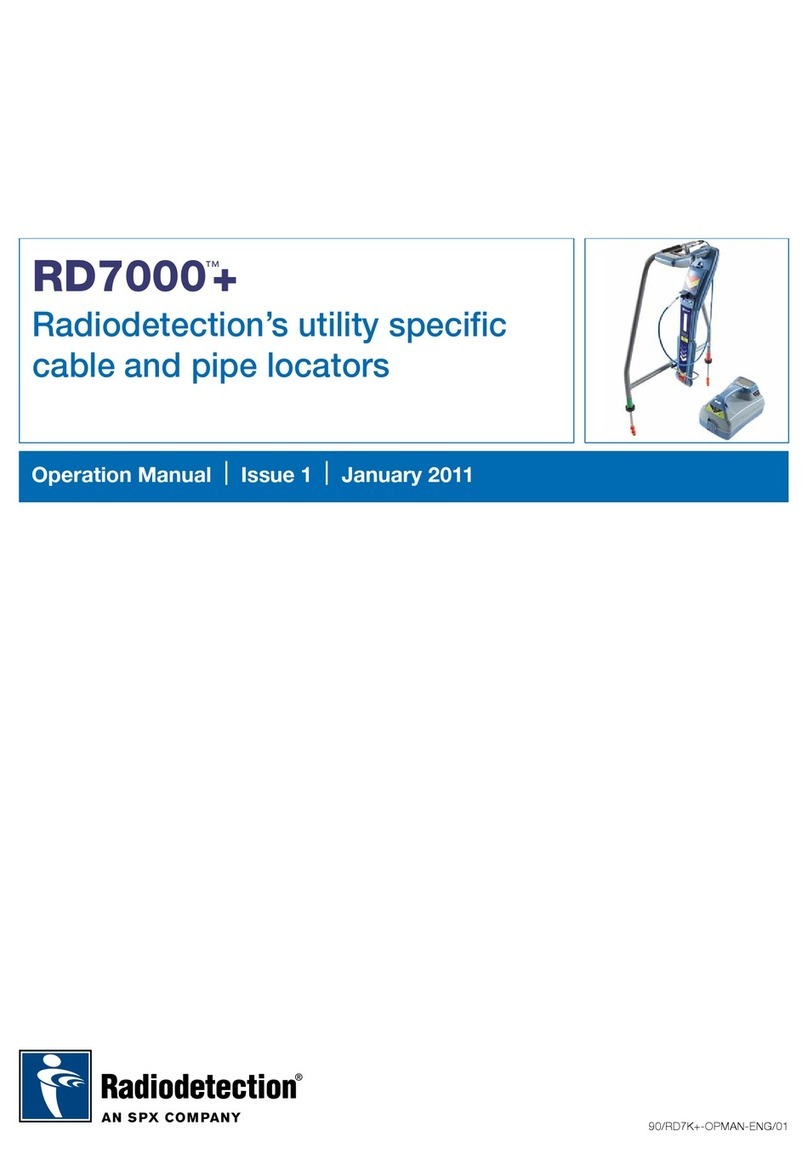
SPX
SPX Radiodetection RD7000+ User manual
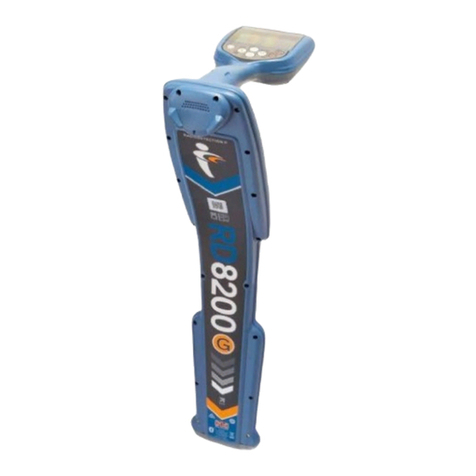
SPX
SPX Radiodetection RD8200 User manual

SPX
SPX Radiodetection RD8200 User manual
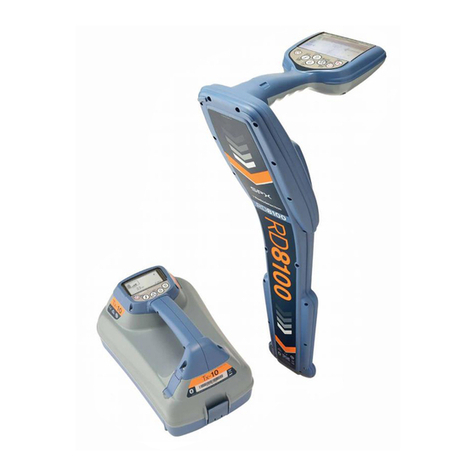
SPX
SPX Radiodetection RD8100 User manual
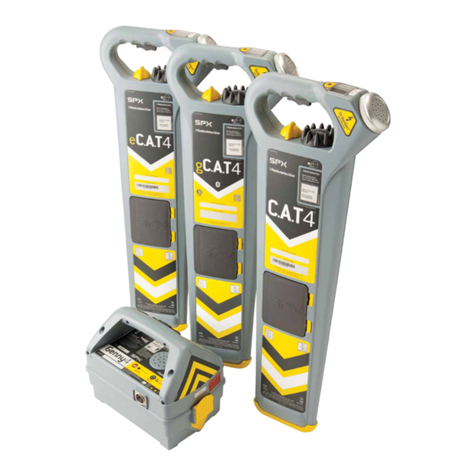
SPX
SPX C.A.T4 User manual
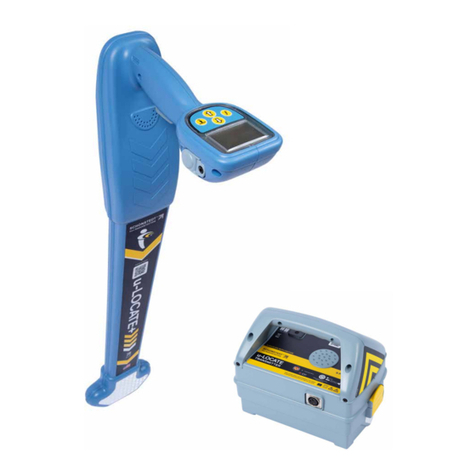
SPX
SPX Radiodetection Schonstedt u-LOCATE User manual
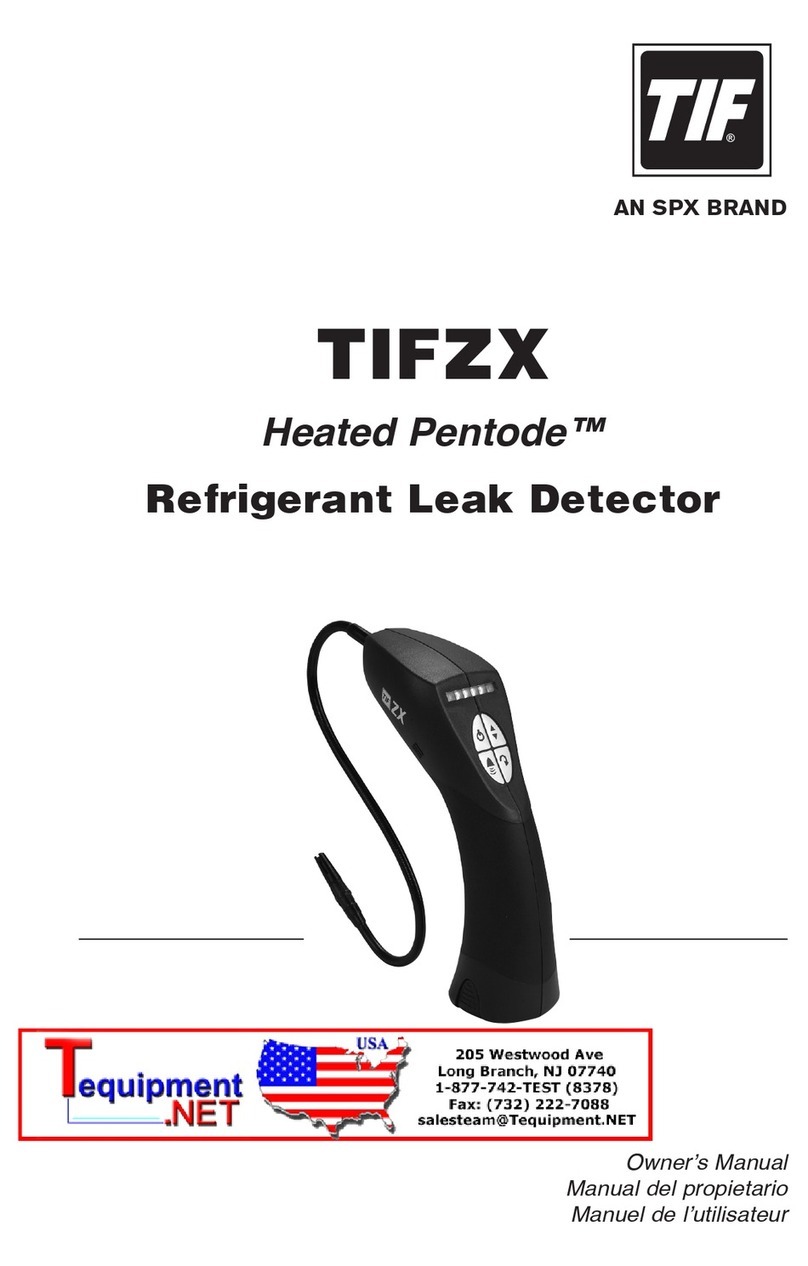
SPX
SPX TIF Heated Pentode TIFZX User manual

SPX
SPX Radiodetection RD7100 User manual

SPX
SPX Radiodetection RD7100 User manual

SPX
SPX Sensory Trainers Instruction manual

